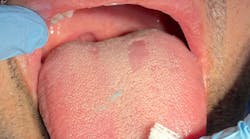The mind-mouth connection: Psychological implications of oral pathologies
Oral health encompasses more than maintaining an esthetically pleasing smile; it is deeply intertwined with overall health and well-being. Dental hygienists play a pivotal role not only in maintaining oral health but also in recognizing and addressing the significant psychological and social effects accompanying oral pathologies. From a psychological standpoint, the mouth is more than just an anatomical structure. It plays a crucial role in communication, self-expression, and social interaction. The impact of oral pathologies on these functions underscores the intimate connection between oral health and psychological well-being, a core principle guiding the interdisciplinary approach to supporting patients with oral health concerns while creating a nurturing and supportive environment that empowers patients to manage the emotional challenges of oral conditions, ultimately improving their quality of life.
Before examining the complex interplay between oral health and psychological well-being, it’s vital to understand the fundamental concept of oral pathology. Essentially, oral pathology refers to any deviation from a healthy oral state, encompassing a broad spectrum of diseases, injuries, or disorders affecting the teeth, gums, jaws, and surrounding oral structures. Prominent examples of oral pathologies include temporomandibular joint disorders, oral cancers, facial trauma, cleft lip and palate, and severe periodontal disease.
Many of these pathologies will be accompanied by chronic pain, which is defined as pain lasting more than three months. Chronic pain is a significant burden, affecting physical and emotional well-being.1 It can result in sleep disturbances, anxiety, and depression, complicating the patient’s daily functioning and mental health. A dental professional must appreciate the profound impact of chronic pain and functional limitations in otherwise normal functions, such as eating, speaking, and even smiling, leading to diminished social interactions and lower self-esteem in our patients.
The interplay between oral pathologies and psychological health
Extensive research highlights a strong link between oral health and overall well-being. Individuals with oral pathologies frequently experience lower life satisfaction, increased psychological distress, and diminished self-worth. This emphasizes the need for a comprehensive approach to oral health care that acknowledges the interrelationship between physical symptoms and psychological well-being. By recognizing this connection, health-care professionals can provide more empathetic and holistic treatment plans, incorporating pain management strategies and collaborating with other disciplines to address functional limitations, thereby improving patients’ overall quality of life.
Psychological challenges of oral pathologies
Each oral pathology presents a unique set of psychological challenges, and dental hygienists must recognize these nuances as they personalize care to meet each patient’s specific emotional and psychological needs.
Temporomandibular disorders: The chronic pain and functional limitations of temporomandibular disorders (TMD) often trigger a cycle of psychological distress, including frustration, anxiety, and depression, exacerbated by unpredictable flare-ups.2 Some studies state that women are potentially more susceptible due to biological and sociocultural factors and may struggle with heightened pain sensitivity and societal pressures to endure pain silently.3 But no matter the gender, chronic stress linked to TMD can lead to physiological changes such as vasoconstriction and increased muscle tension, worsening pain, and dysfunction, where sleep disruptions and bruxism can highlight the complex interplay between physical and psychological factors in TMD.4
Oral cancer: On the other hand, a diagnosis of oral cancer can trigger a cascade of emotional distress, often fueled by the profound fear of death, disfigurement, and the potential loss of vital oral functions. This psychological burden, particularly pronounced in women experiencing low social support who face a heightened risk of psychosocial dysfunction, adds another layer of complexity to the already challenging physical aspects of the disease and its treatment.5,6
Head and neck cancer significantly impacts our patients’ quality of life. Posttreatment these individuals face considerable hurdles in adapting to altered functions such as swallowing, chewing, eating, and speaking, in addition to changes in their physical appearance. The perception of disfigurement can lead to numerous social adjustment difficulties, with many patients reporting feelings of stigmatization and experiencing negative social interactions.
Deno et al.7 developed a scale to measure this social distress in Japanese head and neck cancer patients with facial disfigurement. The study revealed two key dimensions of this distress: social avoidance and distress about appearance. Notably, surgical interventions were more strongly linked to social distress than radiotherapy or chemotherapy, likely due to their greater potential for visible changes. Furthermore, women were found to be more prone to distress about their appearance, consistent with prior research. Interestingly, factors traditionally associated with social support—such as family status, job status, and marital status—were not directly correlated with social distress in this study. This suggests that the quality of a patient’s social interactions and relationships may be more crucial than their mere existence. It is conceivable that facial disfigurement can alter the dynamics of social engagement for head and neck cancer patients, leading to feelings of distress regardless of their relationship status.
Craniofacial anomalies: Individuals with craniofacial anomalies, such as cleft lip and palate (CLP), face a multitude of challenges, including speech, hearing, and social acceptance difficulties.8,9 These hurdles can lead to feelings of isolation, anxiety, and low self-esteem, particularly during the formative years of childhood and adolescence. The physical manifestations of these anomalies, ranging from deformities of the skull and facial bones to irregularities in the teeth and jaw, can further compound the emotional challenges.10
Some studies reveal a significantly higher prevalence of anxiety and depression in adults with CLP compared to those without. Dissatisfaction with facial appearance is a strong predictor of depression in this population. Moreover, research has demonstrated elevated social anxiety and avoidance behaviors in individuals with CLP, highlighting the profound impact of these conditions on social well-being.11
Severe periodontal disease: Finally, let’s focus on an often-underestimated side of the intricate mind-mouth connection: the profound psychological toll of severe periodontal disease. The unfortunate consequences of tooth loss, receding gums, and halitosis can affect an individual’s self-esteem and social confidence, leaving them feeling isolated and vulnerable. While research has shed light on the role of chronic stress, especially in those grappling with mental illness, as a contributing factor to periodontal disease, the reverse relationship—how periodontal disease may affect mental well-being—remains a largely uncharted territory waiting for further exploration.
Recent studies have unveiled a compelling link between mental health challenges and compromised oral health, even when considering socioeconomic and demographic factors.12 Internalizing disorders, such as the heavy burdens of depression and anxiety, appear to have the most consistent association with adverse oral health outcomes. Emerging evidence points toward a dynamic relationship between mental and oral health, where the state of one can influence the trajectory of the other over time. This underscores the critical need for a collaborative and compassionate approach to care, bridging the gap between mental health and dental practitioners.
Merging physical and psychological care
A holistic approach that integrates physical and psychological care allows hygienists to empower patients to confront and manage the challenges posed by their conditions.13 Dental hygienists play a key role in patient care by fostering clear, empathetic communication and providing comprehensive patient education. By utilizing simple language, visual aids, and gentle techniques, they create a safe and trusting environment where patients feel comfortable enough to ask questions and actively participate in their treatment decisions. Active listening and validation of emotions are also crucial in building a strong therapeutic alliance and ensuring patients feel heard and understood. When necessary, hygienists can go the extra mile by recognizing signs of emotional distress and referring patients to appropriate mental health resources. This commitment to holistic care underscores the importance of a multidisciplinary approach in addressing the complex needs of individuals with oral pathologies.
Effective communication is a two-way street where ideas are exchanged clearly, accurately, concisely, comprehensively, and in a well-organized way. By giving patients the knowledge they need to make informed decisions about their oral health, dental hygienists can help bridge the gap between dental care and overall well-being.14
Psychological interventions and quality of life
Evidence suggests that psychological interventions improve the quality of life for individuals with oral pathologies. Mindfulness-based interventions (MBIs) and other approaches, such as cognitive-behavioral therapy (CBT) and peer support groups, have demonstrated effectiveness in reducing anxiety, depression, and chronic pain while fostering enhanced coping skills and self-esteem. These positive outcomes extend beyond clinical symptoms to address overall well-being, including improvements in cognitive biases, emotional regulation, and interpersonal skills.15-18
Empowering hygienists, empowering patients
Beyond their clinical expertise, dental hygienists play an important role in acknowledging and addressing the psychological and social impact of oral pathologies. Creating a supportive environment through clear communication, compassionate care, empathy, and interdisciplinary collaboration allows patients to navigate the emotional challenges associated with their conditions, promoting healing, resilience, and well-being.19 This holistic approach enriches patients’ lives and dental hygienists’ professional experience, reminding us of the profound and positive impact we can have.
Editor's note: This article appeared in the November/December 2024 print edition of RDH magazine. Dental hygienists in North America are eligible for a complimentary print subscription. Sign up here.
References
- Chou R, Turner JA, Devine EB, et al. The effectiveness and risks of long-term opioid therapy for chronic pain: a systematic review for a National Institutes of Health Pathways to Prevention Workshop. Ann Intern Med. 2015;162(4):276-286. doi:10.7326/M14-2559
- Emodi-Perlman A, Eli I. One year into the COVID-19 pandemic – temporomandibular disorders and bruxism: what we have learned and what we can do to improve our manner of treatment. Dent Med Probl. 2021;58(2):215-218. doi:10.17219/dmp/132896
- Shalev-Antsel T, Winocur-Arias O, Friedman-Rubin P, et al. The continuous adverse impact of COVID-19 on temporomandibular disorders and bruxism: comparison of pre- during- and post-pandemic time periods. BMC Oral Health. 2023;23(1):716. doi:10.1186/s12903-023-03447-4
- Knibbe W, Lobbezoo F, Voorendonk EM, Visscher CM, de Jongh A. Prevalence of painful temporomandibular disorders, awake bruxism and sleep bruxism among patients with severe post-traumatic stress disorder. J Oral Rehabil. 2022;49(11):1031-1040. doi:10.1111/joor.13367
- Katz MR, Irish JC, Devins GM, Rodin GM, Gullane PJ. Psychosocial adjustment in head and neck cancer: the impact of disfigurement, gender and social support. Head Neck. 2003;25(2):103-112. doi:10.1002/hed.10174
- De Sousa A. Psychological issues in acquired facial trauma. Indian J Plast Surg. 2010;43(2):200-205. doi:10.4103/0970-0358.73452
- Deno M, Tashiro M, Miyashita M, et al. Developing the social distress scale for head and neck cancer outpatients in Japan. Palliat Support Care. 2011;9(2):165-172. doi:10.1017/S1478951511000034
- Branson EK, Branson VM, McGrath R, Rausa VC, Kilpatrick N, Crowe LM. Psychological and peer difficulties of children with cleft lip and/or palate: a systematic review and meta-analysis. Cleft Palate Craniofac J. 2024;61(2):258-270. doi:10.1177/10556656221125377
- Hunt O, Burden D, Hepper P, Johnston C. The psychosocial effects of cleft lip and palate: a systematic review. Eur J Orthod. 2005;27(3):274-285. doi:10.1093/ejo/cji004
- Singh VP, Moss TP. Psychological impact of visible differences in patients with congenital craniofacial anomalies. Prog Orthod. 2015;16:5. doi:10.1186/s40510-015-0078-9
- Marcusson A, Paulin G, Ostrup L. Facial appearance in adults who had cleft lip and palate treated in childhood. Scand J Plast Reconstr Surg Hand Surg. 2002;36(1):16-23. doi:10.1080/028443102753478327
- Kalaigian A, Chaffee BW. Mental health and oral health in a nationally representative cohort. J Dent Res. 2023;102(9):1007-1014. doi:10.1177/00220345231171108
- Deno M, Tashiro M, Miyashita M, et al. The mediating effects of social support and self-efficacy on the relationship between social distress and emotional distress in head and neck cancer outpatients with facial disfigurement. Psychooncology. 2012;21(2):144-152. doi:10.1002/pon.1877
- Ho JCY, Chai HH, Lo ECM, Huang MZ, Chu CH. Strategies for effective dentist-patient communication: a literature review. Patient Pref Adherence. 2024;18:1385-1394. doi:10.2147/PPA.S465221
- Hilton L, Hempel S, Ewing BA, et al. Mindfulness meditation for chronic pain: systematic review and meta-analysis. Ann Behav Med. 2017;51(2):199-213. doi:10.1007/s12160-016-9844-2
- Ball EF, Sharizan ENSM, Franklin G, Rogozińska E. Does mindfulness meditation improve chronic pain? A systematic review. Curr Opin Obstet Gynecol. 2017;29(6):359-366. doi:10.1097/GCO.0000000000000417
- Kriakous SA, Elliott KA, Lamers C, Owen R. The effectiveness of mindfulness-based stress reduction on the psychological functioning of healthcare professionals: a systematic review. Mindfulness (N Y). 2021;12(1):1-28. doi:10.1007/s12671-020-01500-9
- Hofmann SG, Gómez AF. Mindfulness-based interventions for anxiety and depression. Psychiatr Clin North Am. 2017;40(4):739-749. doi:10.1016/j.psc.2017.08.008
- Sucre A. Empathy in the face of uncertainty: a hygienist’s guide to difficult conversations. RDH magazine. April 30, 2024. https://www.rdhmag.com/patient-care/article/55031570/empathy-in-the-face-of-uncertainty-a-hygienists-guide-to-difficult-conversations
About the Author

Andreina Sucre, MSc, RDH
Andreina Sucre, MSc, RDH, is an international dentist, oral pathology, and oral surgery specialist practicing dental hygiene in Miami, Florida. A passionate advocate for early pathological diagnosis, she empowers colleagues through lectures focused on oral pathologies. Andreina spoke on this topic at the 2024 ADHA Annual Conference, 2023 RDH Under One Roof, and she writes about oral pathology for RDH magazine. Committed to community outreach, she educates non-native English-speaking children on oral health and actively volunteers in dental initiatives.



